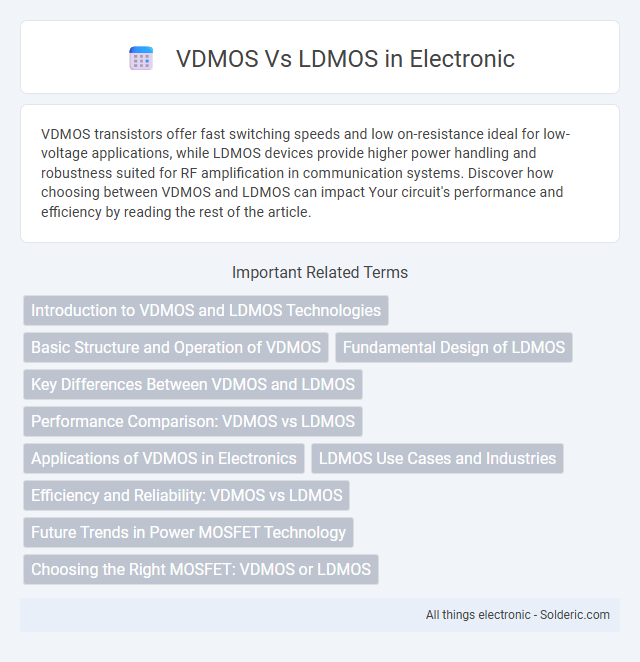VDMOS transistors offer fast switching speeds and low on-resistance ideal for low-voltage applications, while LDMOS devices provide higher power handling and robustness suited for RF amplification in communication systems. Discover how choosing between VDMOS and LDMOS can impact Your circuit's performance and efficiency by reading the rest of the article.
Comparison Table
| Feature | VDMOS (Vertical DMOS) | LDMOS (Lateral DMOS) |
|---|---|---|
| Structure | Vertical current flow through the substrate | Lateral current flow parallel to the surface |
| Voltage Handling | High voltage capability (up to several hundred volts) | Moderate to high voltage capability (up to ~100 V) |
| On-Resistance (RDS(on)) | Lower RDS(on) due to vertical conduction path | Higher RDS(on) compared to VDMOS |
| Switching Speed | Slower switching speed | Faster switching speed |
| Applications | Power supplies, motor drivers, and high-voltage switching | RF power amplifiers, audio amplifiers, and low-voltage high-speed switches |
| Frequency Performance | Limited high-frequency performance | Better high-frequency response |
| Manufacturing | More complex substrate processing | Easier fabrication with standard CMOS processes |
Introduction to VDMOS and LDMOS Technologies
VDMOS (Vertical Diffused Metal-Oxide Semiconductor) and LDMOS (Laterally Diffused Metal-Oxide Semiconductor) are advanced power transistor technologies used in high-frequency and high-power applications. VDMOS devices offer vertical current flow, providing low on-resistance and high efficiency for switching applications, while LDMOS transistors feature lateral current flow optimized for RF amplification with improved linearity and gain. Understanding the structural differences between VDMOS and LDMOS helps you select the ideal transistor technology for your power electronics or RF circuit design needs.
Basic Structure and Operation of VDMOS
VDMOS (Vertical Double-diffused MOSFET) features a vertical structure with current flowing from the source at the top to the drain at the bottom, allowing for high voltage handling and efficient switching. Its operation relies on a double-diffused channel formed between the source and drain regions, enabling low on-resistance and fast switching speeds. Your choice of VDMOS is ideal for applications requiring compact size and high-frequency performance due to its vertical current flow and optimized channel formation.
Fundamental Design of LDMOS
LDMOS (Laterally Diffused Metal-Oxide-Semiconductor) transistors feature a unique lateral diffusion process allowing the integration of a high-voltage drift region and a channel in a single device, improving breakdown voltage and efficiency. Unlike VDMOS (Vertical Diffused MOSFET), LDMOS uses a planar structure optimized for RF power amplification, providing enhanced linearity and frequency response. The fundamental design of LDMOS includes a lightly doped drift region laterally extending beneath the gate, which controls the device's on-resistance and high-voltage handling capabilities.
Key Differences Between VDMOS and LDMOS
VDMOS (Vertical Double-diffused MOSFET) features a vertical current flow path with low on-resistance, making it suitable for high-speed switching and power efficiency in low to medium voltage applications. LDMOS (Laterally Diffused MOSFET) has a lateral structure optimized for higher voltage operations and better RF performance, widely used in wireless communication amplifiers. Key differences include their structural design, voltage handling capabilities, and application focus, with VDMOS excelling in power efficiency and LDMOS offering superior linearity and power gain at microwave frequencies.
Performance Comparison: VDMOS vs LDMOS
VDMOS transistors offer faster switching speeds and lower on-resistance, making them ideal for low-voltage, high-frequency applications. LDMOS devices excel in high-power and high-frequency RF amplification due to their superior breakdown voltage and linearity. Your choice between VDMOS and LDMOS depends on the specific performance requirements of your power or RF application.
Applications of VDMOS in Electronics
VDMOS transistors are widely used in power management circuits, DC-DC converters, and motor control applications due to their high-speed switching capabilities and low on-resistance. They excel in low-voltage power supplies and consumer electronics where efficiency and fast switching are critical. VDMOS devices also play a crucial role in RF amplifiers and signal processing circuits within telecommunication systems.
LDMOS Use Cases and Industries
LDMOS transistors are widely used in RF power amplification for wireless communication infrastructure, including base stations for 4G and 5G networks, due to their high efficiency and robustness at high frequencies. They also play a critical role in broadcasting transmitters, industrial heating, and radar systems, where reliable high-power performance is essential. The semiconductor industry's reliance on LDMOS technology supports its prominence in telecommunications, aerospace, and defense sectors.
Efficiency and Reliability: VDMOS vs LDMOS
LDMOS transistors typically offer higher efficiency and superior reliability in high-power RF applications due to their lateral structure, which provides better thermal management and robustness under high voltage stress. VDMOS devices, while effective in low to medium power scenarios, generally exhibit lower efficiency and reliability when subjected to high power and frequency demands. The optimized drift region in LDMOS allows for reduced on-resistance and improved saturation voltage, contributing to enhanced performance and longer device lifespan compared to VDMOS.
Future Trends in Power MOSFET Technology
Future trends in power MOSFET technology emphasize the shift from VDMOS (Vertical Double-diffused MOSFET) to LDMOS (Laterally Diffused MOSFET) due to LDMOS's superior high-frequency performance and higher power efficiency, making it ideal for RF and microwave applications. Advances in LDMOS development focus on enhancing breakdown voltage, reducing ON-resistance, and improving thermal management to support 5G and beyond wireless communication systems. Your choice of MOSFET technology will increasingly depend on the need for reliability, scalability, and energy efficiency in next-generation power and RF devices.
Choosing the Right MOSFET: VDMOS or LDMOS
VDMOS transistors offer low on-resistance and fast switching speeds, making them ideal for low-voltage, high-frequency applications. LDMOS devices excel in high-power RF amplification due to their high breakdown voltage and superior thermal performance. Your choice depends on the required power level, switching frequency, and efficiency needs, with VDMOS suited for low-voltage switching and LDMOS optimized for high-power RF environments.
VDMOS vs LDMOS Infographic

 solderic.com
solderic.com